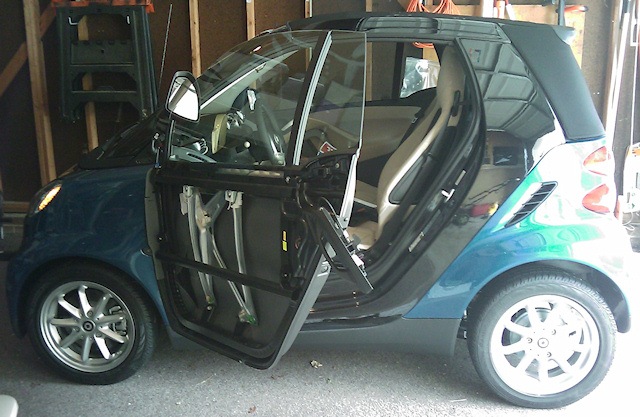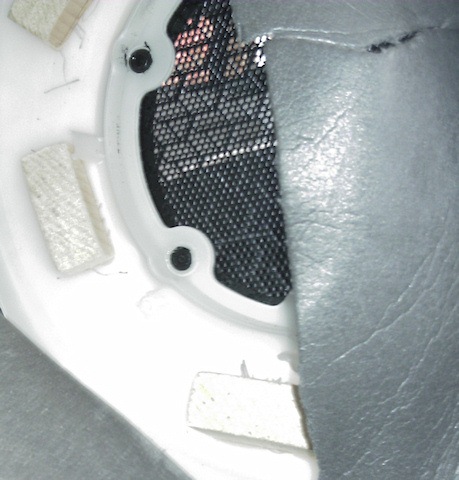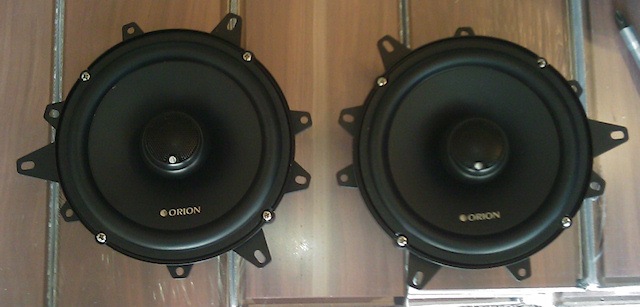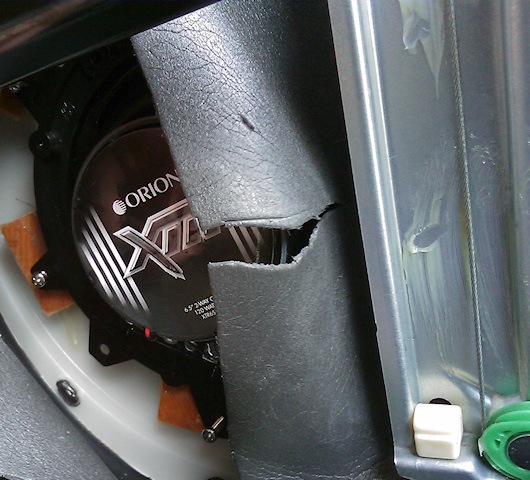Yesterday I posted about swapping out the factory head unit in my Smart Car with an aftermarket unit. Today I am going to cover changing out the door speakers.
The Smart Car is really unlike any other car on the road in its design. To my surprise, to get to the door speaker you have to take off the outside of the door, not the inside. Evilution has great documentation on how to do it. The "premium" sound system also has tweeters in the dash, but I'm leaving those disconnected. It's not worth the effort to replace them. Interestingly, the Smart uses the standard head unit rear channel to power the dash tweeters and the front channel to power the door speakers. If you leave all the wires connected, you can use the fader on your head unit to change the balance between the door and dashboard -- pretty neat.
The factory speakers are terribly cheap looking (no great surprise there). When choosing a new speaker to put in my Smart, I had to make sure the mounting depth was very shallow since there isn't a lot of room. I've always been a huge fan of Orion, so I went to their website first. Orion's XTR 652 coaxial door speakers are surprisingly shallow. In fact, the Orion speaker is actually a few millimeters shorter than the factory speaker!
The inside of the Smart door is basically a single molded piece of plastic. This makes mounting new speakers very difficult unless it has the same screw pattern as the original. Since the original's screw pattern is unique to the Smart, this makes it incredibly unlikely. Orion's door speakers have what they call a universal mount, but sadly there is no screw pattern to match the Smart. Thankfully, the Smart's 6.5 inch speakers are actually 6.5 inches. This isn't always the case on some factory systems! The diameter of the Orion was exactly the same as the factory speaker. This is great because the Smart's plastic speaker mount has an edge that protrudes and presses on the edge of the speaker, just past the surround, but just before the metal case. If the Orion speaker was any bigger, this edge would press on the surround and affect the sound quality and life of the speaker.
Since I wasn't able to use the factory screw holes, I needed to make new ones. The problem is that there is nothing to screw into with the Smart. If I used a long screw and went into the door plastic, it would punch through the other side and you'd see the screw inside the car. That's no good. :-)
My solution was to epoxy little wooden blocks at points where the Orion universal mount had screw points. Where the arm rest is located just above the speaker, I lined the universal mount with the existing screw hole and rethreaded it with a wider screw. So I ended up using one factory screw hole, and three new screw points into the wood blocks that are epoxied on the inside. This worked great, but be careful about one thing: you really need to score the plastic really well before applying the epoxy to it. At first I just used some low grit sandpaper, but that did not do the job. The blocks fell off with only a little bit of force. The second time I used the sharp end of a screw and went to town scoring some nice deep grooves. The epoxy stuck really well after giving it something to grab onto. After that, I just needed to drive some wood screws through the universal mount's screw hole and the job was done.
Surprisingly, the Smart has some pretty good speaker wire connecting the door speakers. Eyeballing, it looked to be around 14 AWG -- not bad! Since I didn't want to fish new wire, I simply snipped the ends off the factory wire and soldered it to the Orion speakers. When I install the amplifier, I'll snip and solder the speaker wire behind the radio and connect a longer cable to the amp. It's not the ideal way to run speaker wire, but I've done this before as a shortcut and it works well. Also, I don't care what anybody says, I cannot tell the difference between Monster Cable and cheap cable when it comes to speaker wire. RCA cables, yes -- absolutely. But speaker wire, no.
Anyway, I put the doors back on and fired up the stereo. Still using the head unit's amp, it sounded amazing! I can't wait to get the amp hooked up now. These XTRs are really great speakers!
I love Orion!
Enjoy the pictures. The next installment of this series will cover hooking up the sub and amplifier.

This is what the door looks like when you take off the outside panel. You can also see that I have cut a "plus" pattern to gain access to the speaker behind the weather shield. It's a shame there isn't a better way to gain access without taking the door apart, but duct tape will fix all!

This is a nice side view of the smart with the door panel removed.

The factory speaker is on the right, the XTR 652 on the left. You can see that the XTR is not quite as deep as the factory, leaving plenty of room for the window to roll down. Also take a note of the magnet size difference!

There are my new screw points! The factory grill will conceal my secret weapons. :-)

The Orion XTR 652s, side by side! You can see the "universal mounting bracket" that lacks Smart screw holes (no great surprise).

The speaker, partially mounted (I forgot to take a picture after I tightened all the screws, so this is the last picture you get).